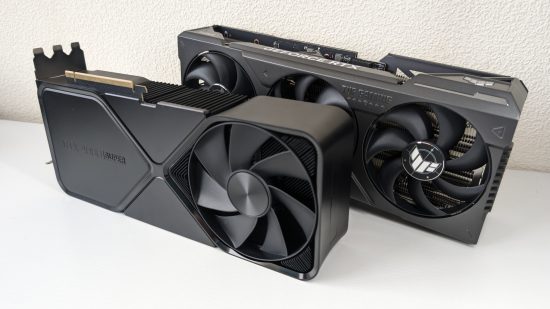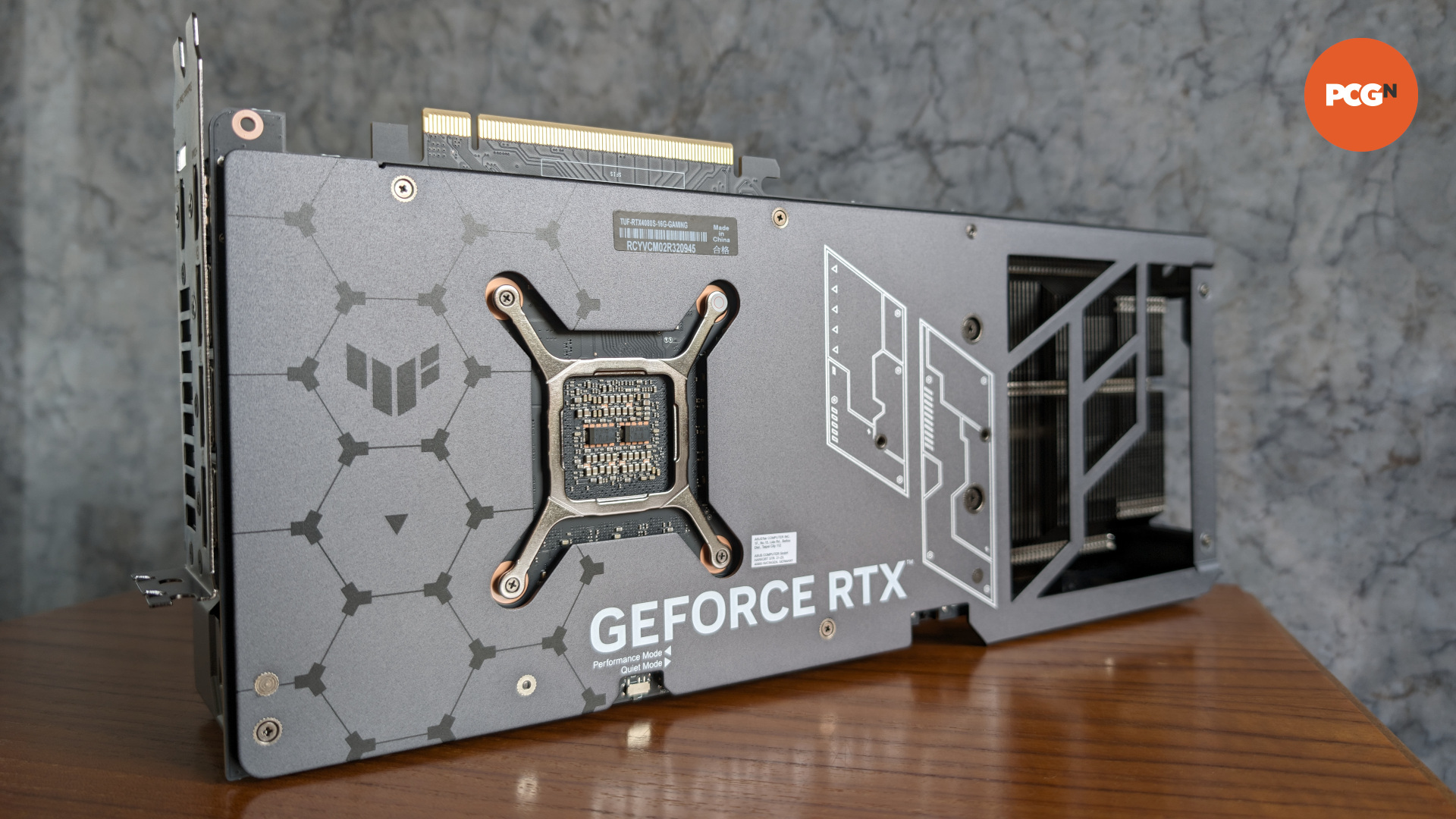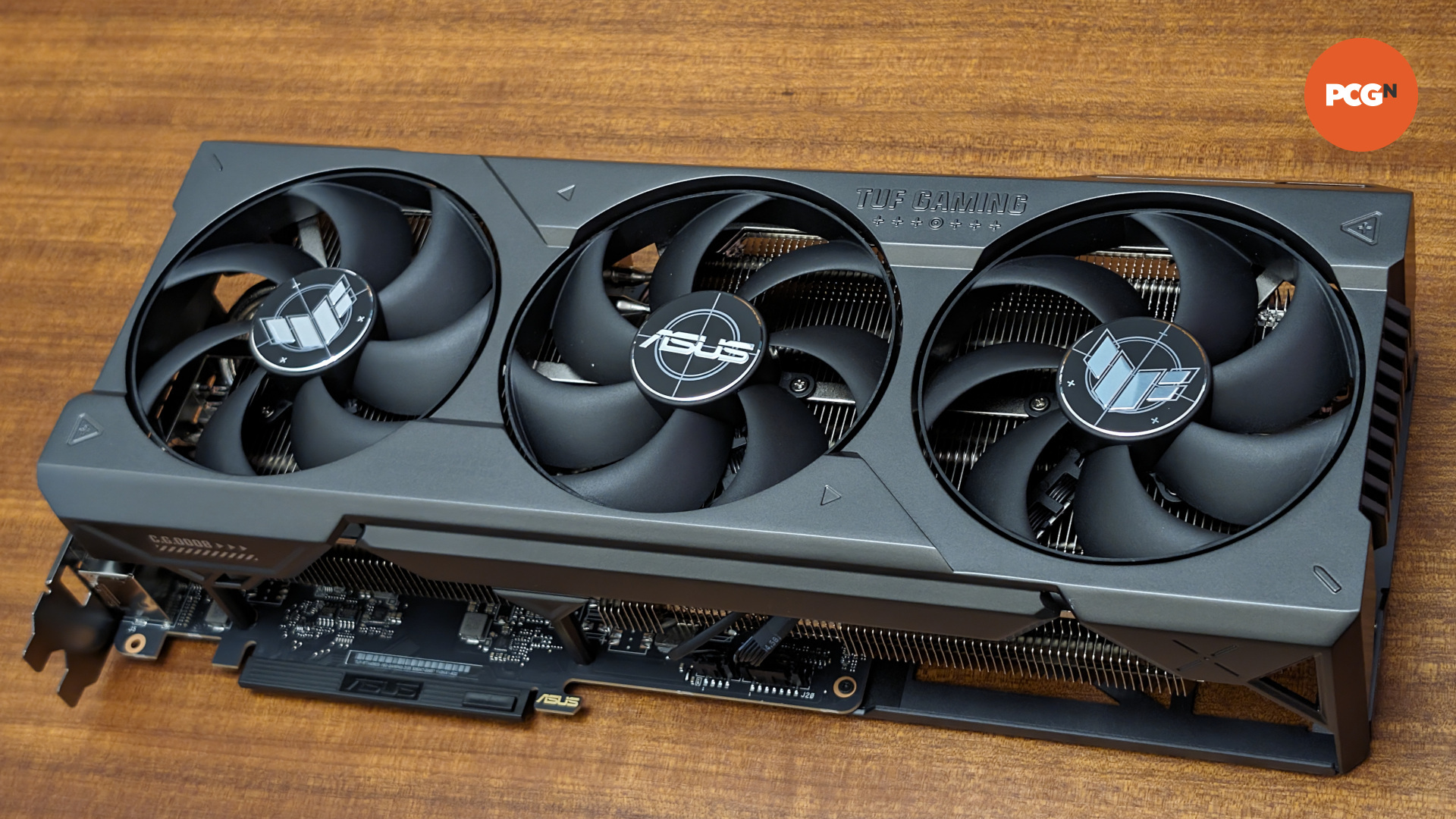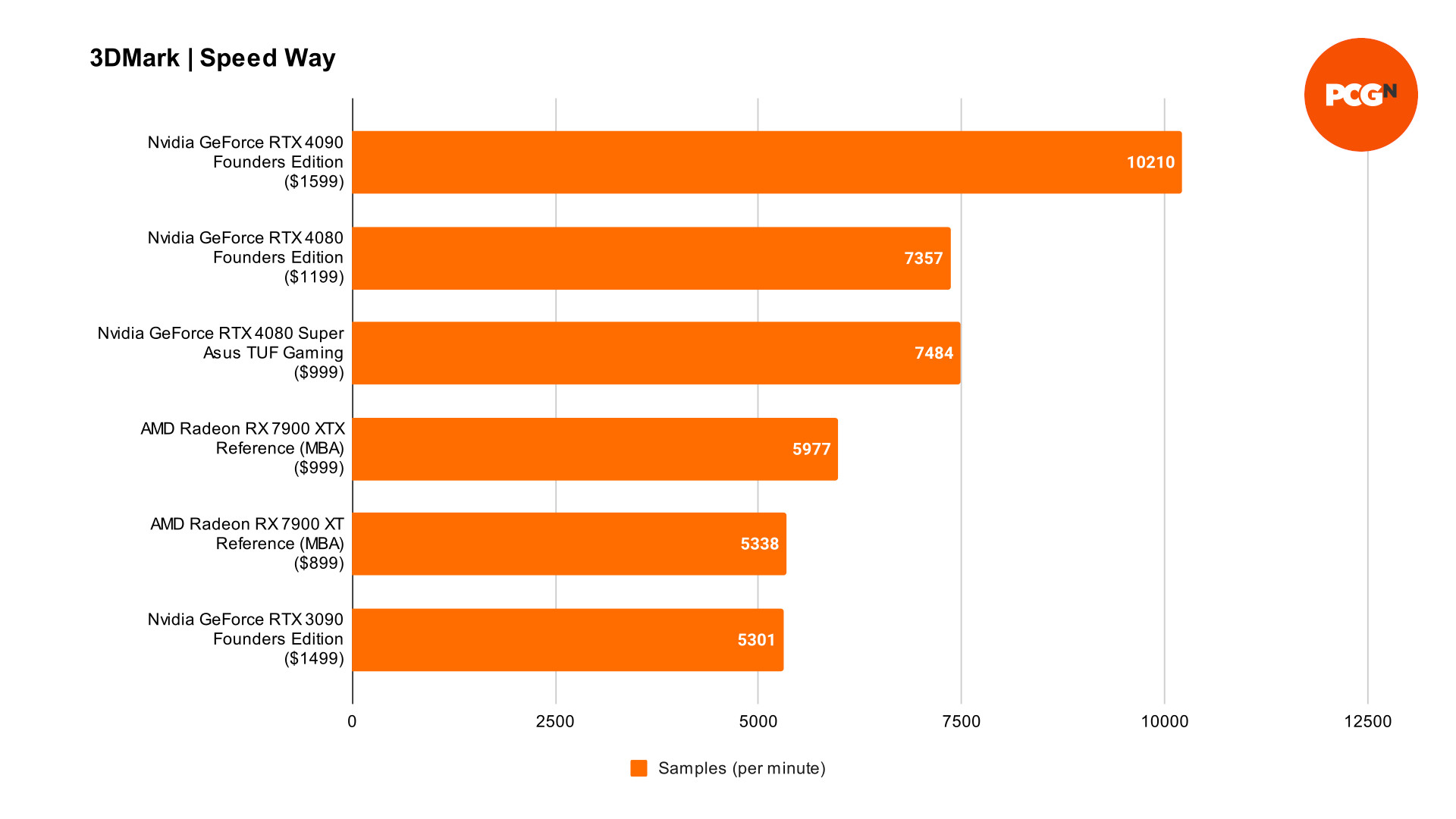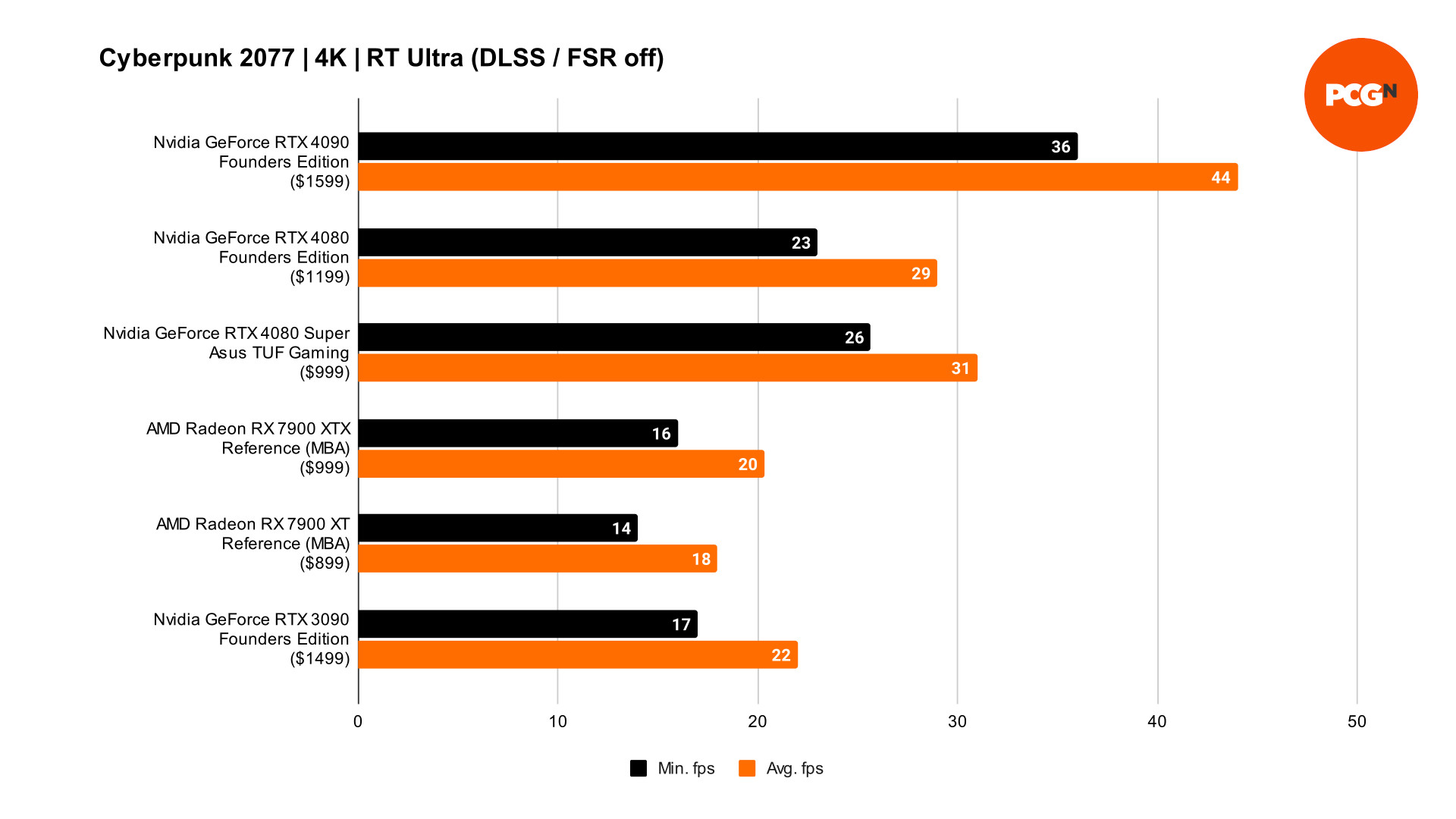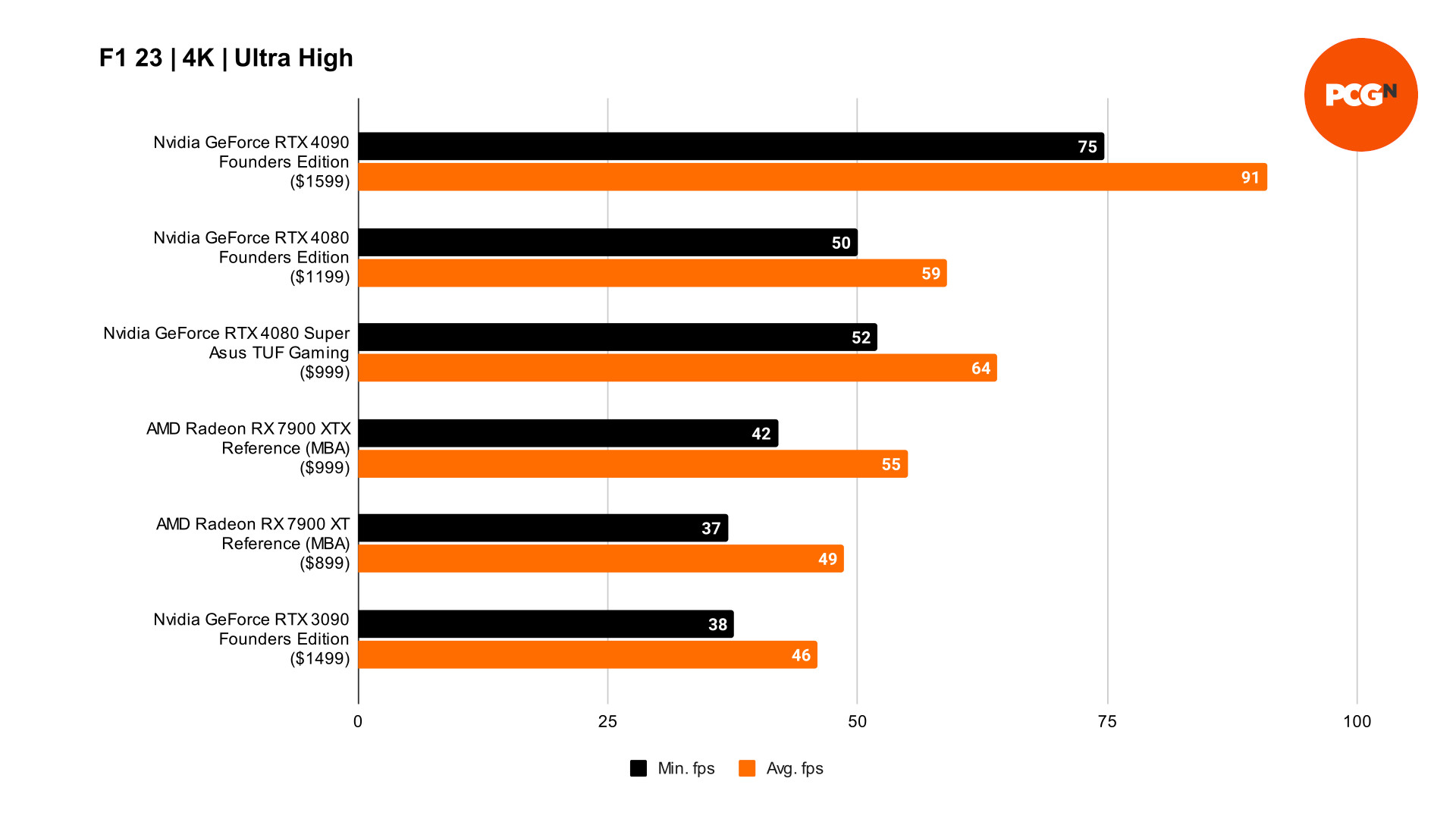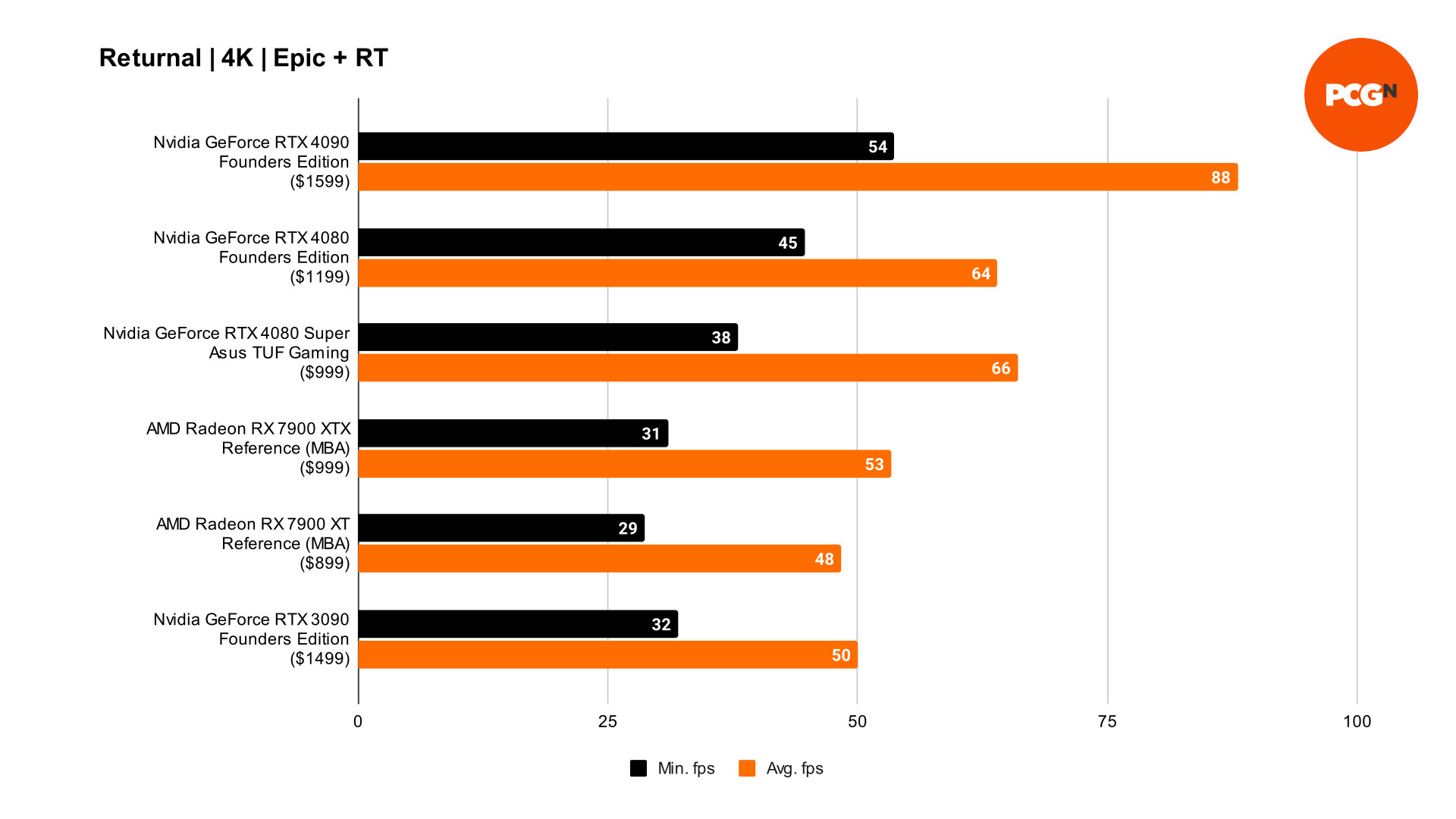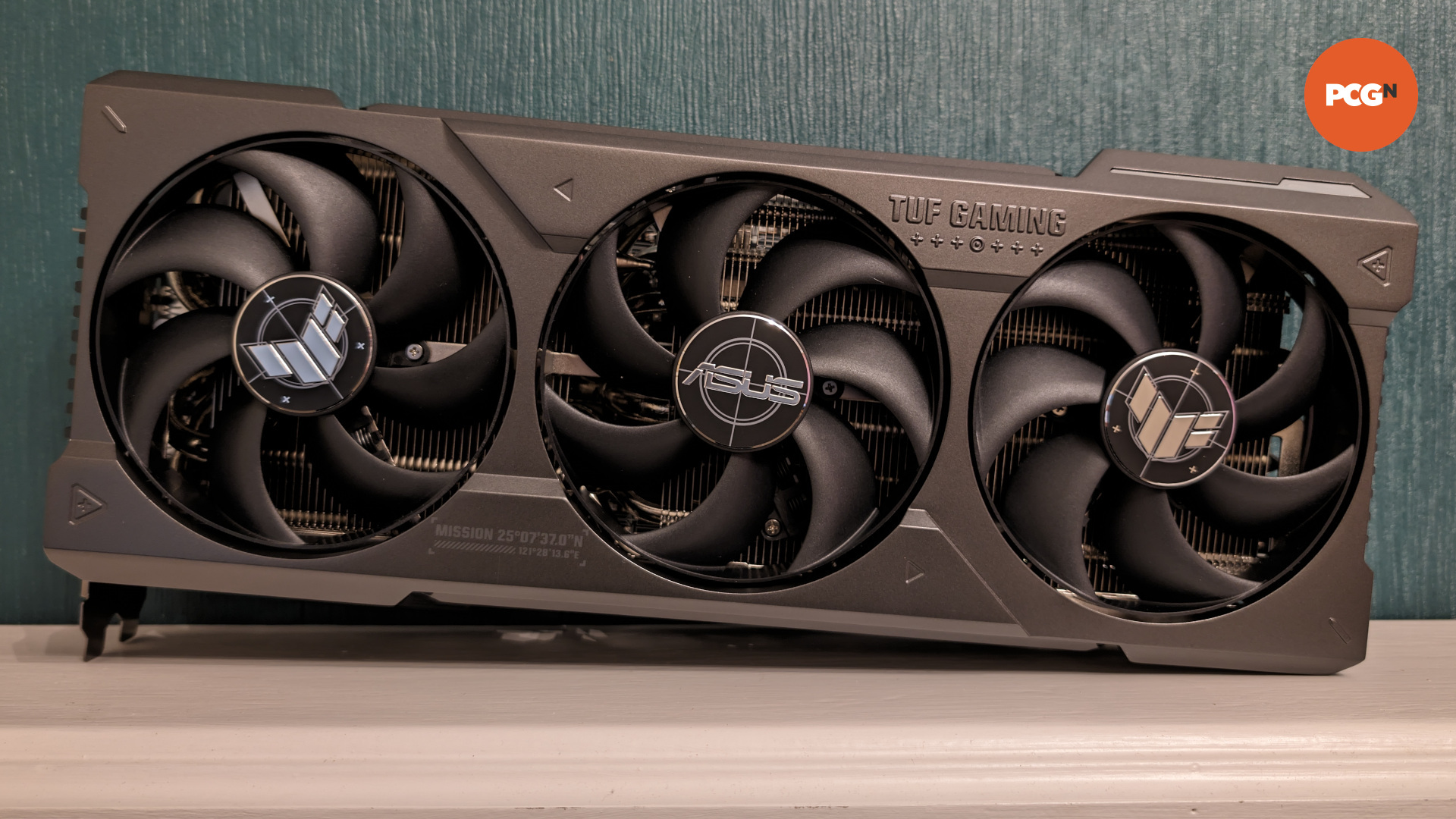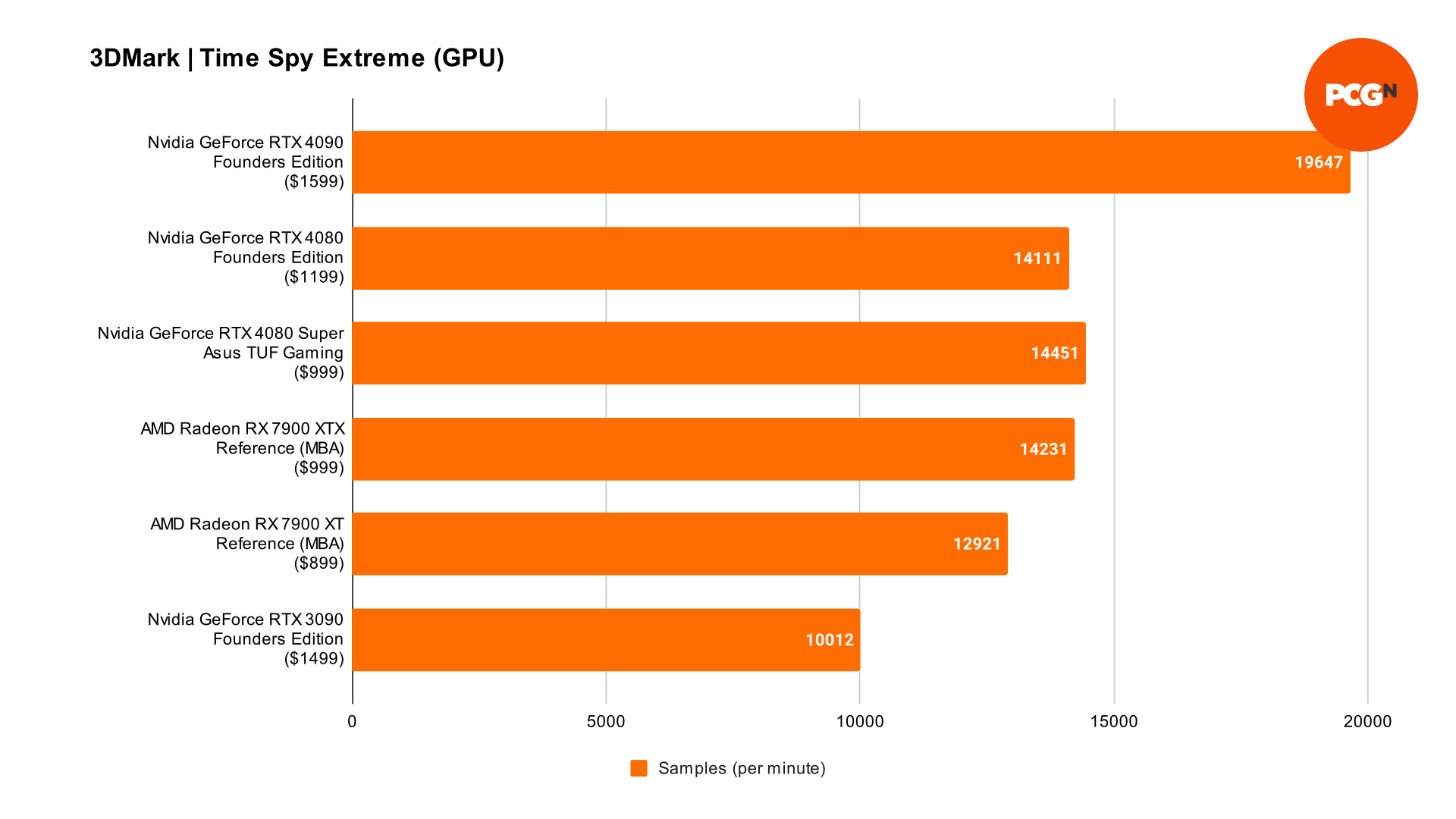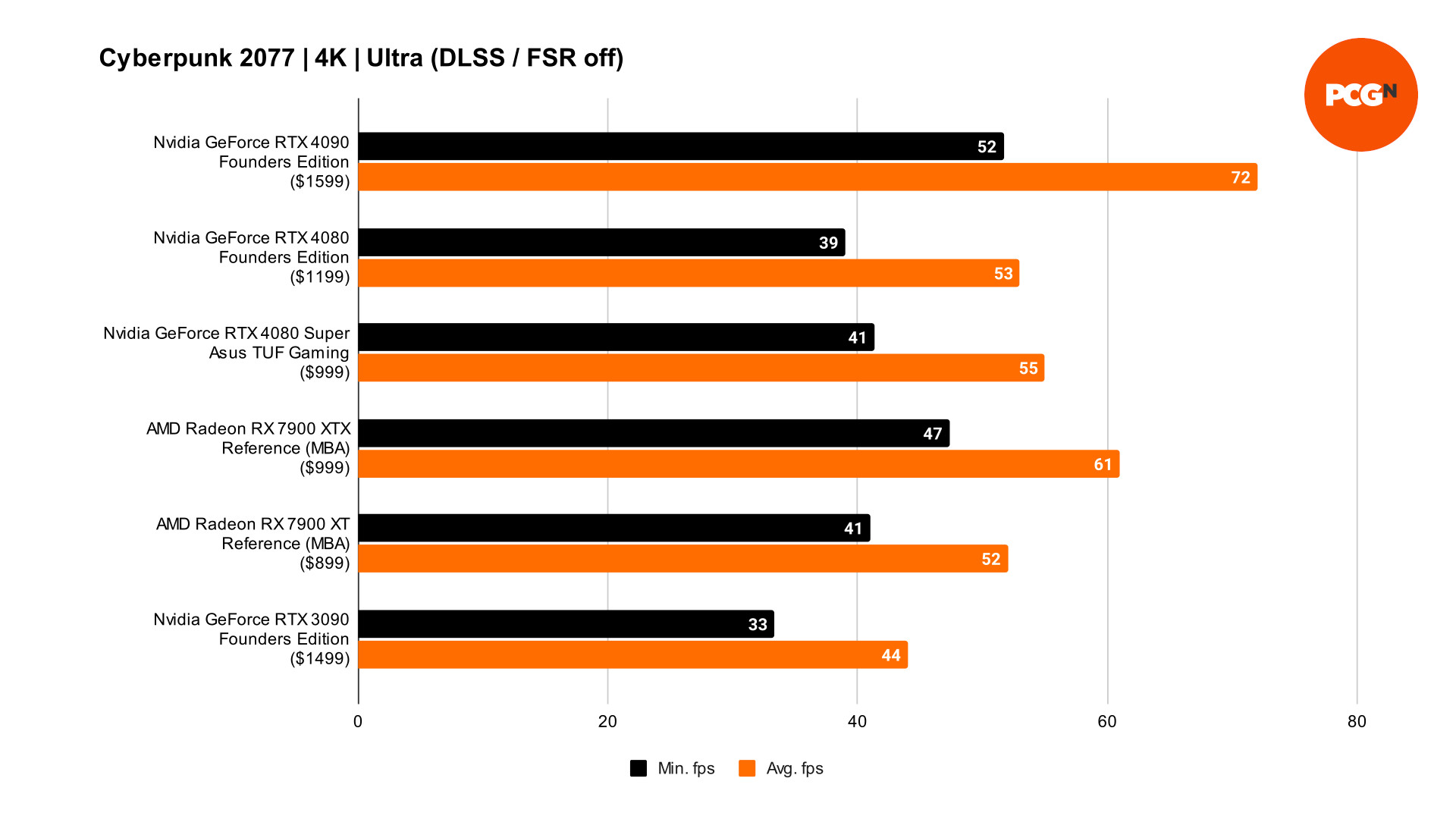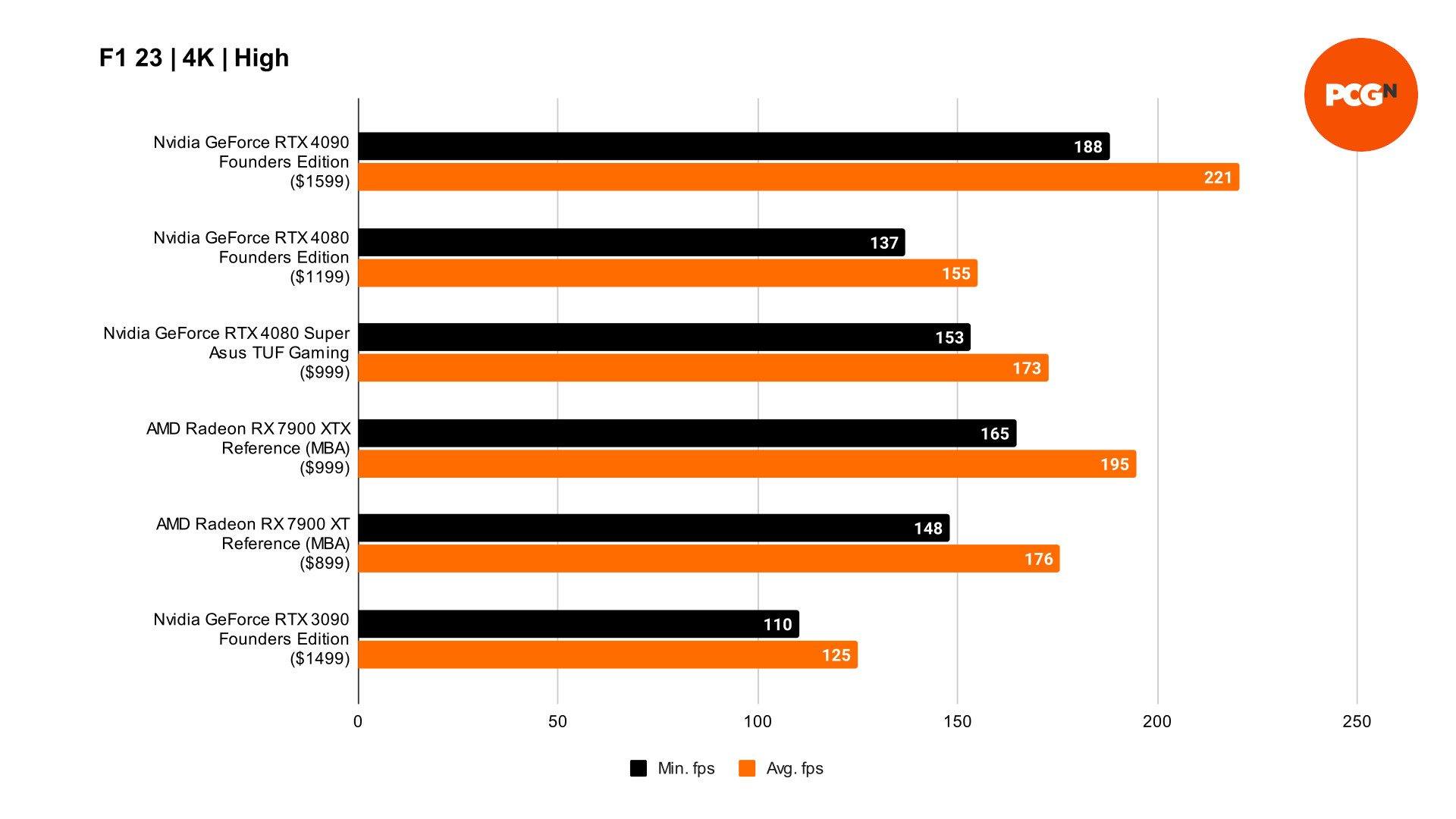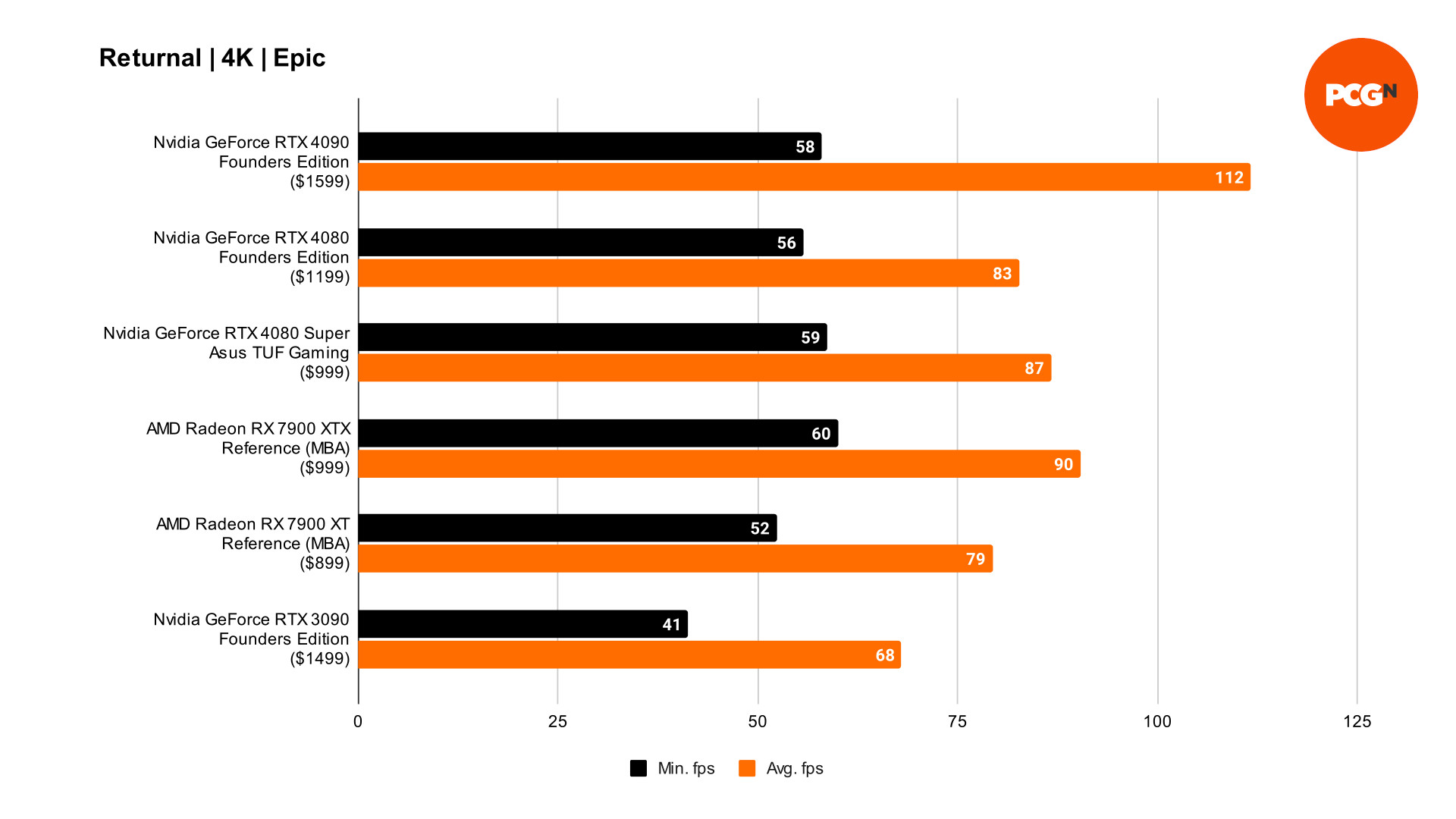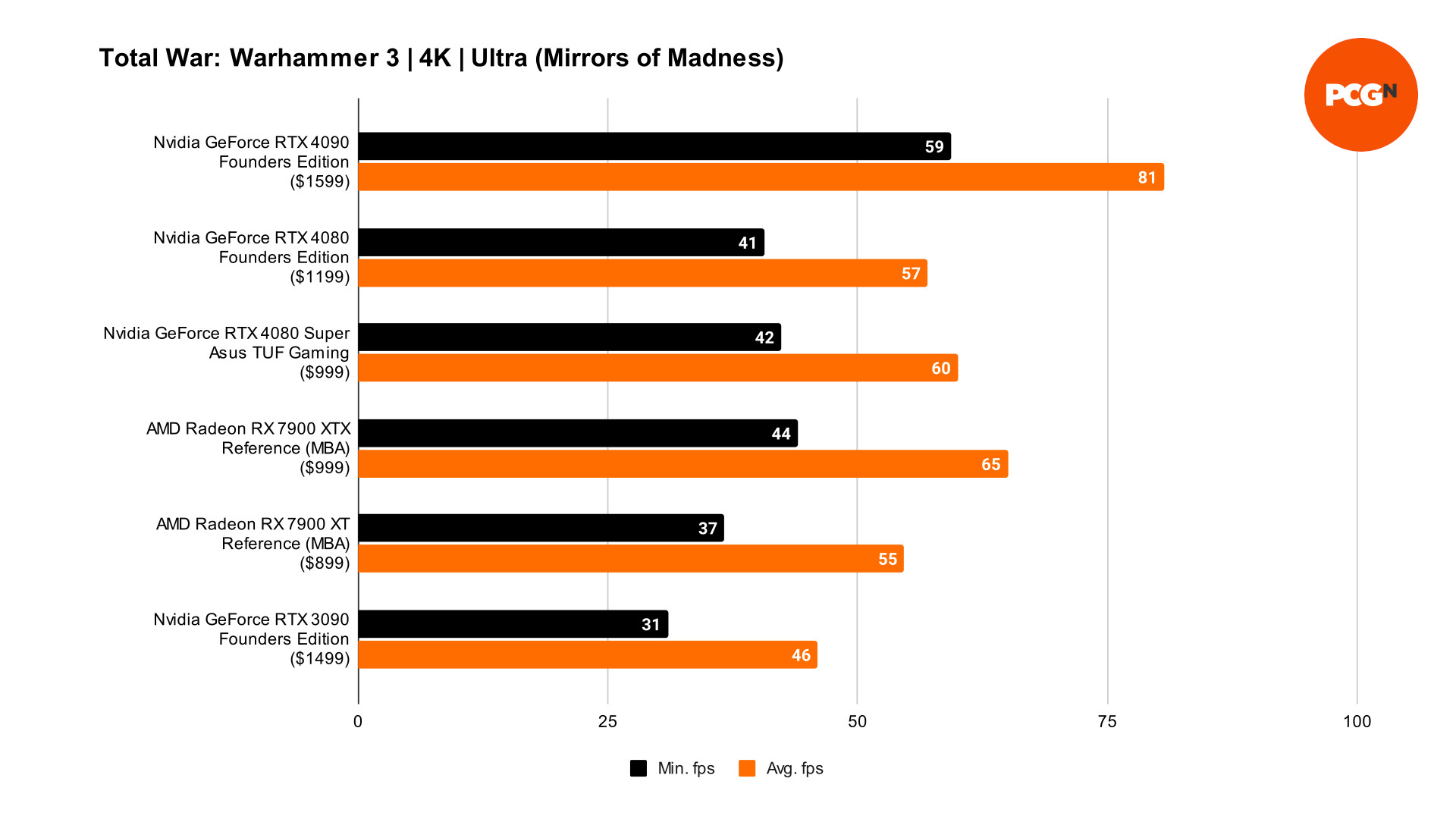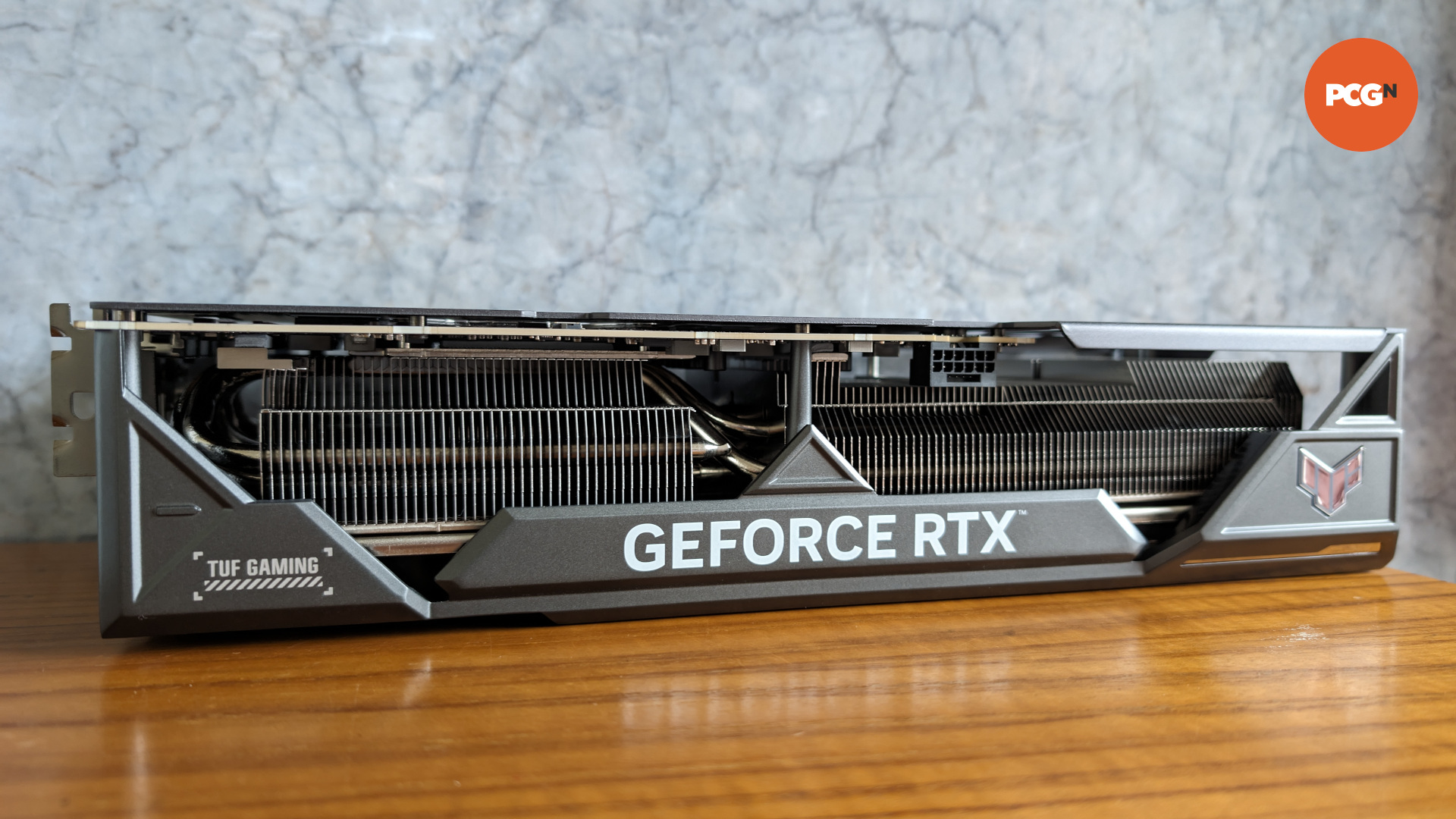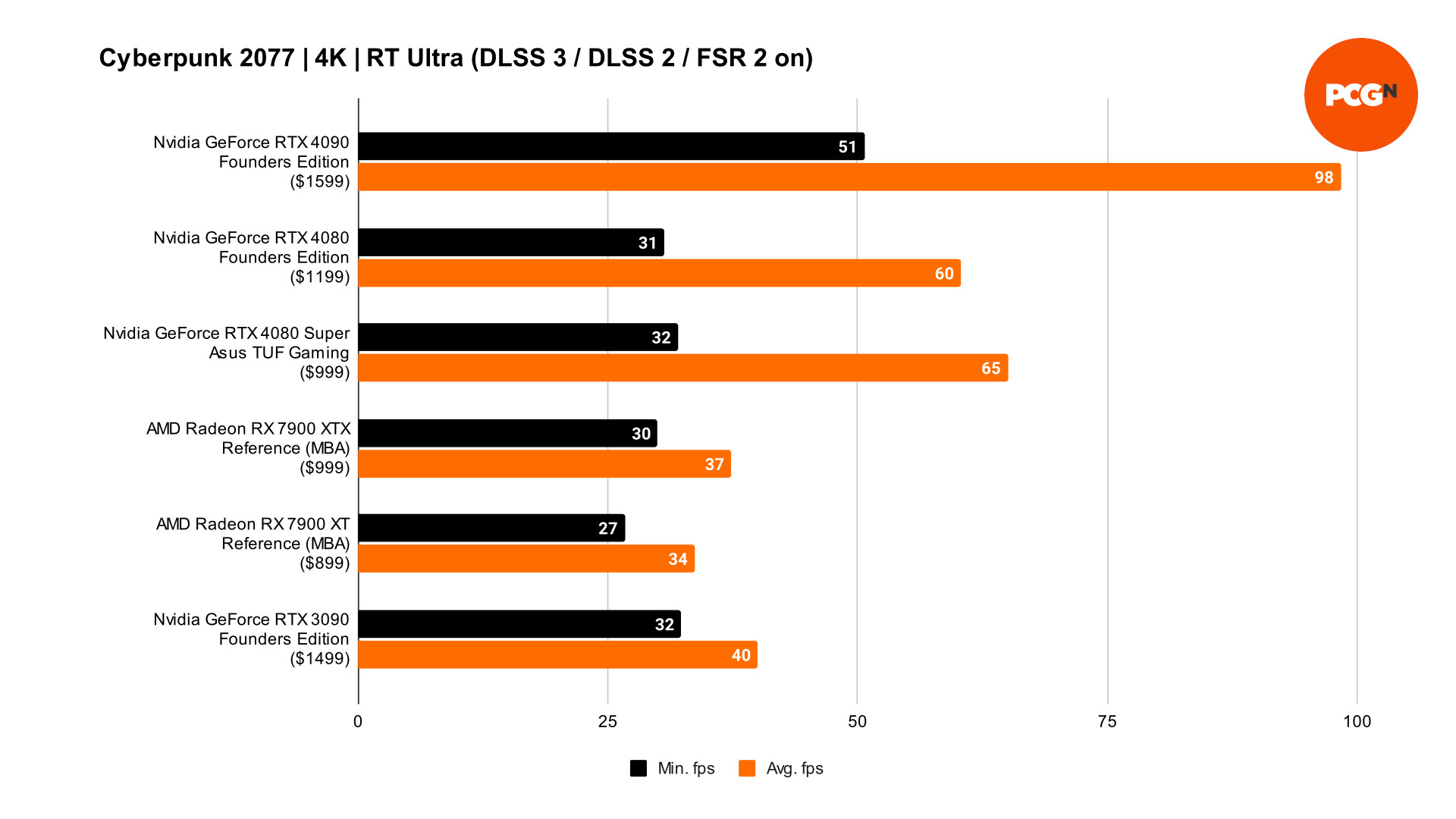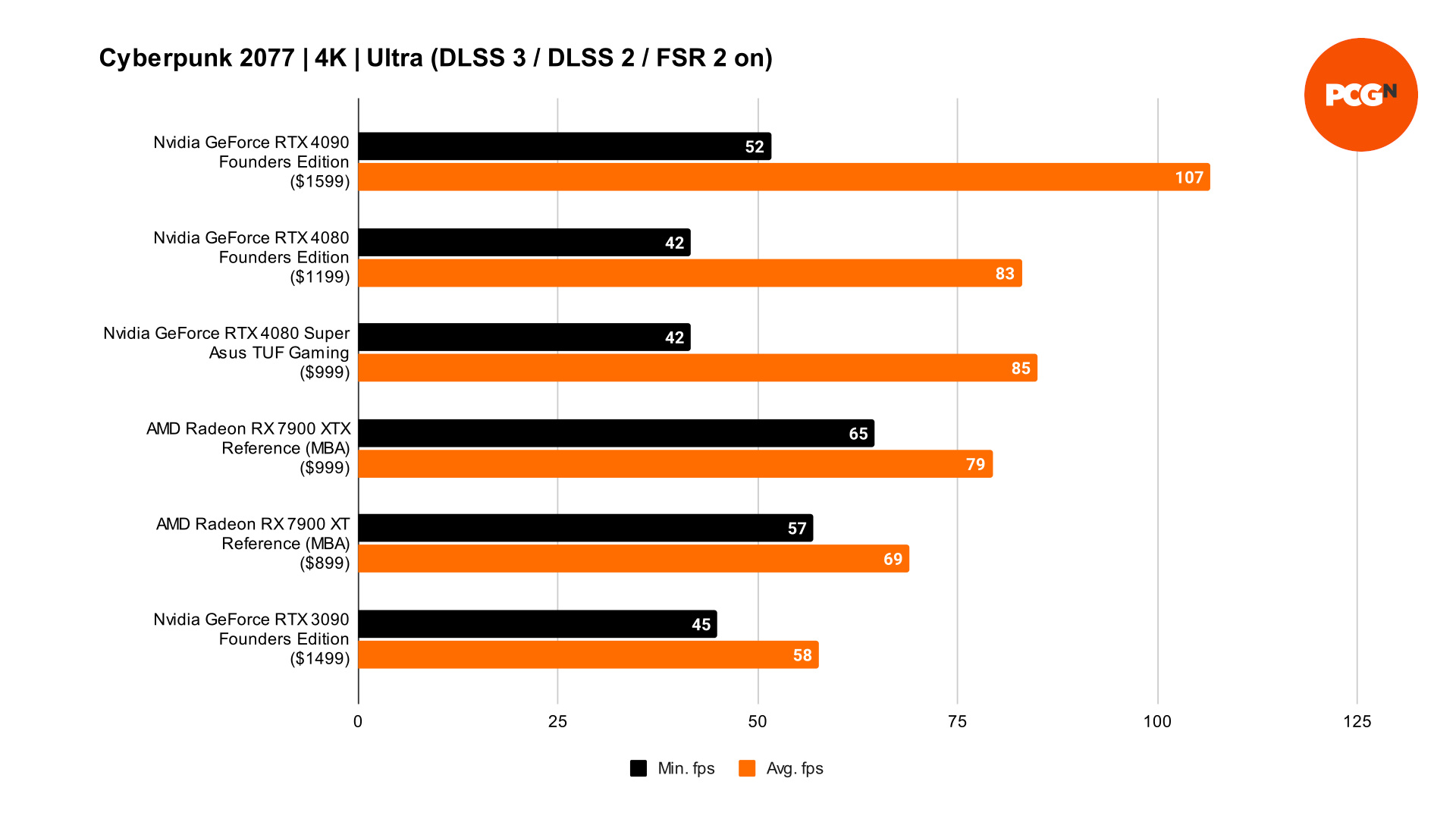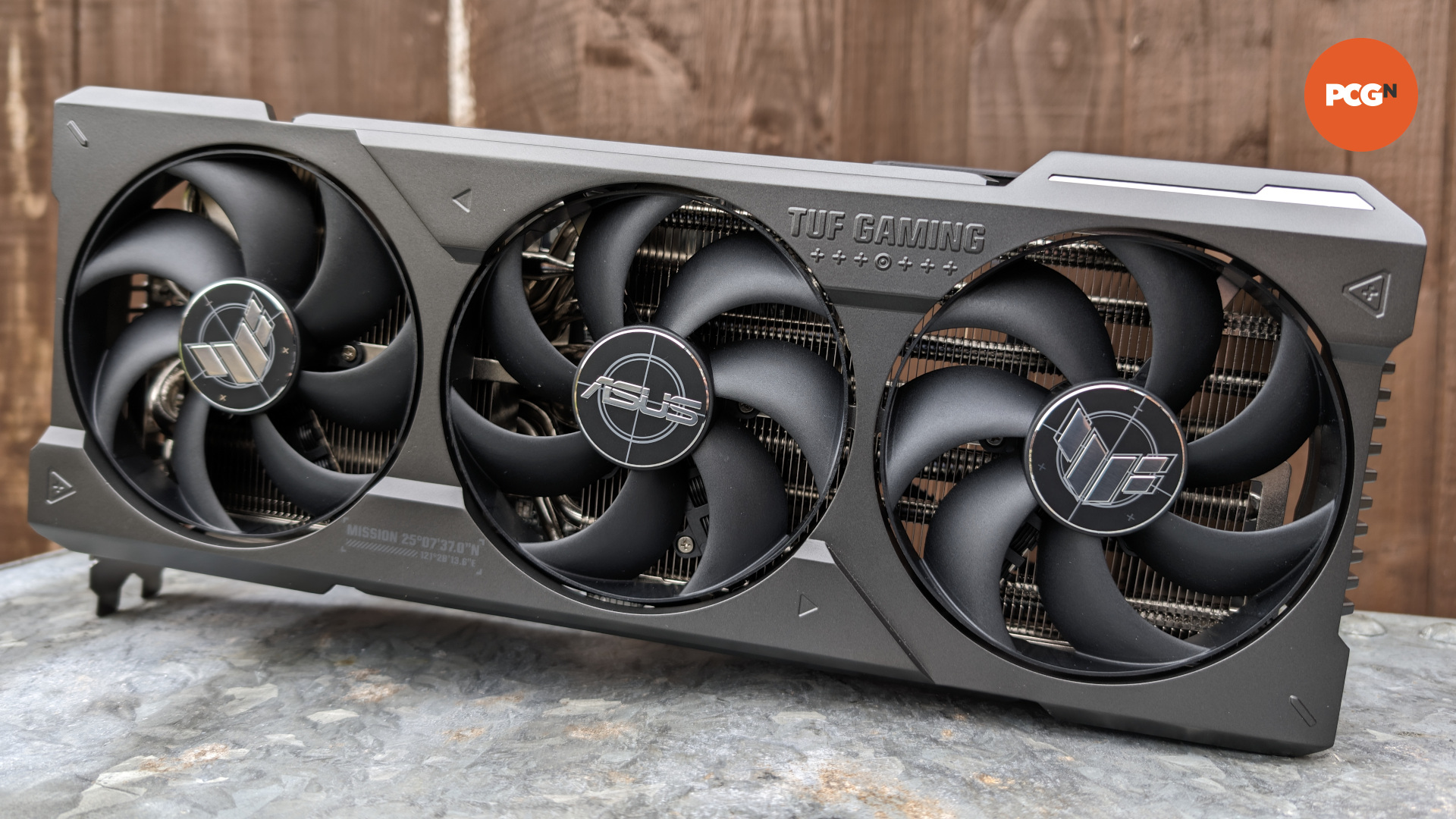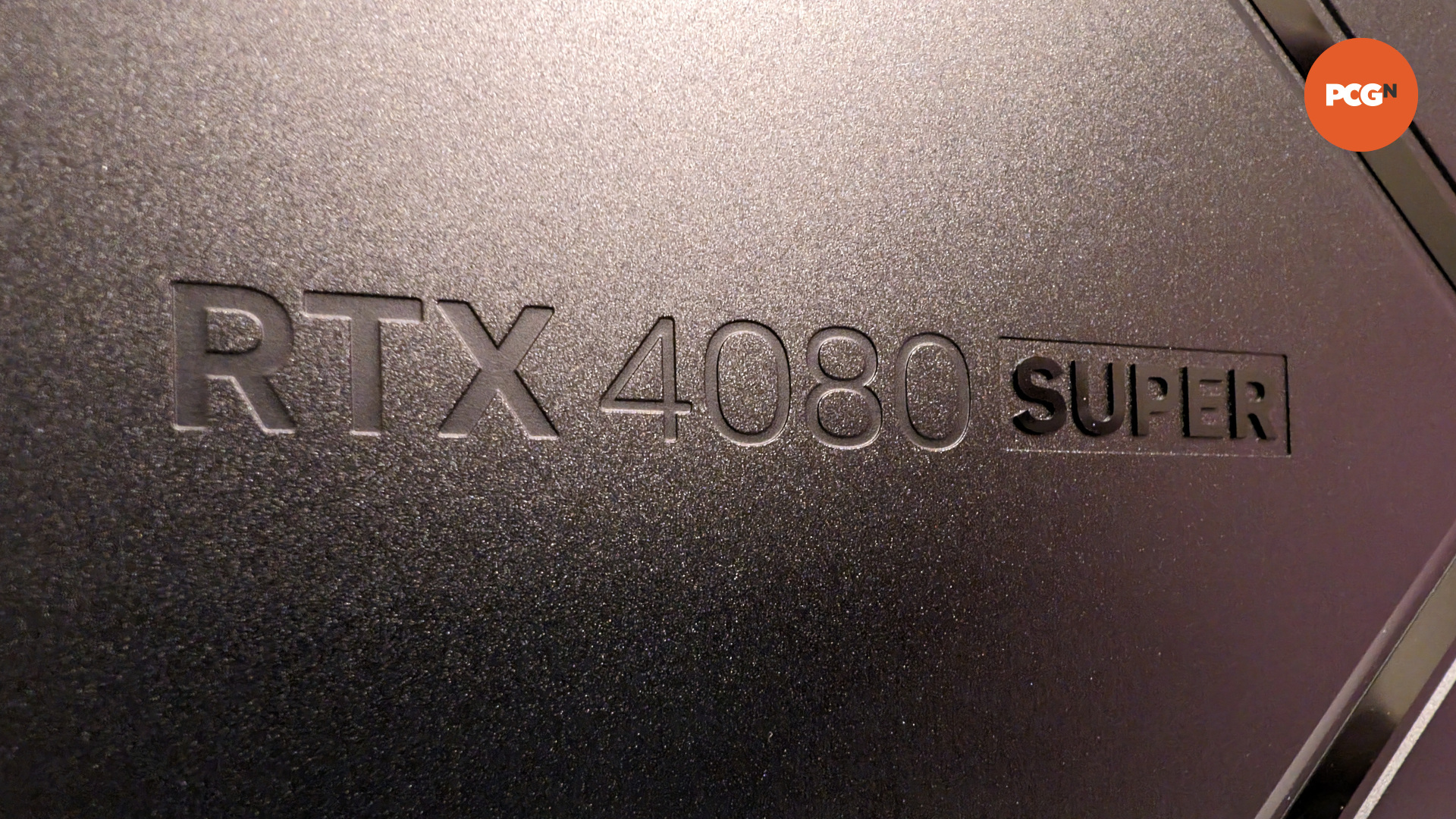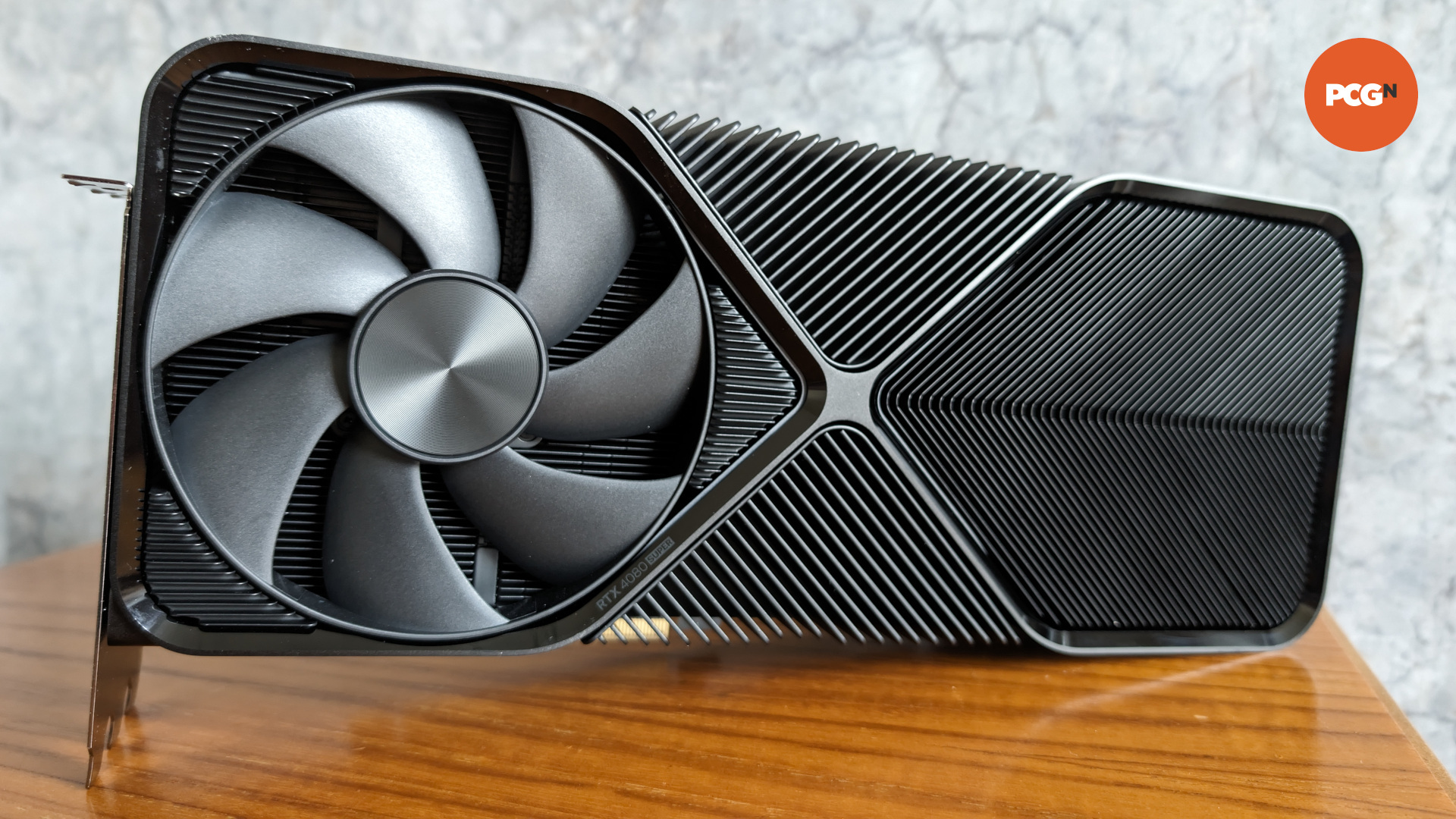Our Verdict
The GeForce RTX 4080 Super isn't a revolutionary refresh in terms of specification or performance uplifts, but its new $999 MSRP dramatically improves its value versus its similarly priced Radeon competition. So much so, in fact, that it's now the de facto option for those with $1,000 to spend on a graphics card, with strong ray tracing and rasterization performance, both of which can be boosted further with DLSS 3.
- Best ray tracing speed under $1,000
- Excellent rasterization frame rates
- Supports DLSS 3
- Slightly slower than RX 7900 XTX outside ray tracing
- Small gains vs original RTX 4080
- Large generational price jump
The GeForce RTX 4080 Super marks the final graphics card refresh we can expect from the Nvidia GeForce RTX 40 series, at least for now, and it’s arguably the most exciting of the bunch. While it offers the smallest performance bump, relative to the previous two releases, its new $999 MSRP is altogether more affordable and better priced than its predecessor, with potentially seismic knock-on effects for the high-end space.
I’ve been testing the RTX 4080 Super over the past few days and was fortunate enough to receive both a Nvidia Founders Edition and an Asus TUF Gaming model. Both are reference class SKUs and perform largely the same based on my testing, but I’ve had my hands on the latter for longer, so it will be the focus of this review. Either card will serve you well, but if I were to pick out the best graphics card between them it would certainly be the stealthier, more mature design of the Founders Edition.
Why you can trust our advice ✔ At PCGamesN, our experts spend hours testing hardware and reviewing games and VPNs. We share honest, unbiased opinions to help you buy the best. Find out how we test.
RTX 4080 Super specs
The improvements made to the RTX 4080 Super specs versus the original graphics card mirror those of the RTX 4070 Super, namely faster clock speeds and higher core counts. However, the degree to which they have all been bolstered is much more modest, which translates into equally modest performance gains.
| RTX 4080 Super | RTX 4080 | |
| GPU | AD103 | AD103 |
| CUDA Cores |
10,240 | 9,728 |
| RT Cores |
80 | 76 |
| Tensor Cores |
320 | 304 |
| Base clock |
2,295MHz (2.23GHz) | 2,205MHz (2.21GHz) |
| Boost clock | 2,550MHz (2.55GHz) | 2,505MHz (2.51GHz) |
| VRAM | 16GB GDDR6X | 16GB GDDR6X |
| Memory bus width | 256-bit | 256-bit |
| TGP | 320W | 320W |
| MSRP | $999 | $1,199 |
All three core types (CUDA, RT, and Tensor) jump in number by 5%, reaching the limits of what’s possible with the AD103 GPU. While Nvidia likely could have put together a cutdown AD102 for the RTX 4080 Super, it’s clear that the company’s primary goal here is to improve value above all else with the graphics card’s new $999 MSRP. Still, the now $600 gap between it and the RTX 4090 does leave room for a possible RTX 4080 Ti using that aforementioned GPU if Nvidia was so inclined.
The base clock rises from 2,205MHz on the RTX 4080 to 2,295MHz on the Super, marking a 290MHz bump. Meanwhile, the RTX 4080 Super boost clock goes up by a practically negligible 45MHz, from 2,505MHz to 2,550MHz. While you could probably achieve these clock speeds on the original card through some mild overclocking, don’t expect to achieve the same performance given the aforementioned difference in core counts.
The memory configuration of the RTX 4080 Super is unchanged, featuring a 256-bit bus and 16GB of GDDR6X VRAM. This leaves it behind both the RX 7900 XTX and XT – its closest rivals – but this setup is still sufficient for running even the most demanding games of today at 4K with ray tracing enabled. Still, more capacity is always welcome, and I’d like to see a Blackwell successor sporting at least 20GB in the coming years.
RTX 4080 Super benchmarks
In conducting our RTX 4080 Super benchmarks, we captured frame rate data at native 1080p, 1440p, and 4K. However, for the sake of relevance, our performance analysis will be focused on 4K, as this is where the card’s capabilities are best suited. Galleries containing our FHD and QHD findings will be forthcoming, for those of you that wish to view them.
| Graphics card test PC specs | |
| GPU | Asus TUF Gaming GeForce RTX 4080 Super |
| Driver | GeForce Game Ready (551.22) |
| OS | Windows 11 Pro (22631.2861) |
| Motherboard | Asus TUF Gaming X670E-Plus (BIOS 2214) |
| CPU | AMD Ryzen 7 7800X3D |
| CPU Cooler | Corsair iCue H150i Elite Capellix XT |
| RAM | Corsair Vengeance 32GB (2 x 16GB) DDR5 6,000MHz |
| SSD | Corsair MP700 Pro 2TB |
| PSU | Corsair RMx Shift Series 1000W |
| Case | Corsair 5000D RGB Airflow |
Our performance metrics were captured using the Asus TUF Gaming model, which serves as a match for the Founders Edition in terms of specification, albeit with a custom cooler. As always, we’ve paired the graphics card with the best gaming CPU available, the AMD Ryzen 7 7800X3D, but even this powerful processor creates a bottleneck for the RTX 4080 Super at lower resolutions.
To create the most insightful comparisons between graphics cards, we have captured fresh frame data for all the GPUs listed in the graphs and described in the paragraphs below. They were benchmarked using the same test PC, using the latest available drivers.
RTX 4080 Super ray tracing benchmarks
Across our ray tracing suite, average frame rates on the RTX 4080 Super come out 5% ahead of the RTX 4080. This is by no means a sizable shift, but once its $999 MSRP is taken into account, the improved value of the new card is made clear.
The RTX 4080 Super leaves both the RX 7900 XT and XTX firmly in the dust when it comes to ray tracing, with respective differentials of 43% and 28% in average frame rate across our test suite. The gap widens further once the minimum frame rate is taken into account, with a 48% and 32% advantage. These percentages are impressive on their own but are all the more so given the RX 7900 XTX MSRP matches that of the RTX 4080 Super, while the 7900 XT is only $100 (10%) cheaper.
While it may rule the roost when it comes to ray tracing performance under $1,000, the RTX 4080 Super is still worlds apart from the RTX 4090. That said, the latter doesn’t look as attractive a purchase as it did compared to the RTX 4080. Previously, the RTX 4080 gave you 65% of the RTX 4090’s performance for 75% of the cost, whereas now you get a better value buy with 72% of its performance for 62% of the cost.
Finally, comparing RT performance to the RTX 3090, we see the RTX 4080 Super pull ahead by a comfortable 39% on average. It’s worth noting that this is without the use of DLSS Super Resolution or Frame Generation too, with the latter widening the performance gap between the two graphics cards, as we’ll cover further on in this review.
RTX 4080 Super – 3DMark ray tracing benchmarks
We begin our analysis with 3DMark, to get a snapshot of the RTX 4080 Super’s ray tracing capabilities relative to its competitors. Unsurprisingly, it comes out on top against all but the RTX 4090.
Looking outside the graph above, the RTX 4080 Super’s closest competitors remain its own siblings, with the RTX 4070 Ti Super and RTX 4070 Ti each outclassing both the RX 7900 XT and XTX.
The RTX 4080 Super is a staggering 40% faster than the RX 7900 XT and 25% ahead of the RX 7900 XTX in this test. The difference between it and the original RTX 4080 is understandably much smaller, clocking in at 2%, with the card falling behind the RTX 4090 by a sizable 27%.
RTX 4080 Super – Avatar: Frontiers of Pandora ray tracing benchmarks
As the most modern game in our suite, Avatar: Frontiers of Pandora is an excellent yardstick to measure the potential longevity of the RTX 4080; in native rendering at least.
Falling short of a 60fps average, the RTX 4080 Super does put in the best performance here at 50fps, and it would no doubt hit the target with some help from DLSS upscaling. Both the RX 7900 XTX and XT trail behind, leaning more suitably towards a native 4K/30fps experience.
To be clear, all these results are admirable, given the performance footprint of the game, but Nvidia remains the clear winner here and, as will become evident, remains so when it comes to ray tracing across basically every game.
RTX 4080 Super – Cyberpunk 2077 ray tracing benchmarks
Despite its age, Cyberpunk 2077’s RT Ultra preset can still bring even the most powerful graphics cards down a peg or two. It should come as no surprise, then, that it proves too much for all but the RTX 4090 when it comes to providing a reliably playable experience.
To the RTX 4080 Super’s credit, it’s the only graphics card save for the RTX 4090 to hit an average frame rate above 30fps. However, its minimum frame rate generally hovers around the 26fps mark, effectively disqualifying its playability. It’s still miles ahead of its Radeon competition, though, whose best performance amounts to 20fps, falling behind the RTX 3090.
RTX 4080 Super – F1 23 ray tracing benchmarks
If ever there was a chance for the RX 7900 XTX to prove its worth against the RTX 4080 Super in ray tracing, it would be through F1 23. However, while AMD’s flagship does turn in a decent result, it still can’t keep up with Nvidia’s offering.
While each graphics card sits comfortably above the 30fps threshold, the RTX 4080 Super is again the only GPU, bar the RTX 4090, to push past a performance barrier, this time of 60fps. This metric is all the more important for F1 23 as a racing game, where responsiveness is key.
RTX 4080 Super – Returnal ray tracing benchmarks
Returnal continues the trend established by the previous games in our suite, with the RTX 4080 Super pulling comfortably ahead of the competition, to the tune of 24% versus the RX 7900 XTX and 36% compared to the RX 7900 XT.
Looking at the RTX 4090, the RTX 4080 Super musters 75% of its sibling’s performance. To hammer this point home before we move on to rasterization, it’s great to see the price adjustment providing much better value.
RTX 4080 Super rasterization benchmarks
Improvements to rasterization performance from the RTX 4080 Super are higher than those of ray tracing compared to the RTX 4080, but still amount to little more than a 6% improvement. While this does help close the gap versus the RX 7900 XTX and XT, Nvidia finds itself on the back foot overall when it comes to this traditional rendering workload.
Despite this concession, though, neither Radeon graphics card enjoys a comparable lead over the RTX 4080 Super. The RX 7900 XT falls behind in all but one benchmark, which still results in a performance gap of around 6% in favor of the RTX 4080 Super. Turning to the RX 7900 XTX, it consistently wins but its lead averages out to just 8% on average.
The RTX 4080 Super provides a greater share of the RTX 4090’s performance when it comes to rasterization, clocking in at 77%. Meanwhile, compared to the RTX 3090, the RTX 4080 Super enjoys a comfortable 30% lead.
RTX 4080 Super – 3DMark rasterization benchmarks
As a reminder, 3DMark serves as a mostly accurate performance snapshot, with Time Spy Extreme testing a graphics card’s rasterization performance at 4K. With this in mind, despite the RTX 4080 Super edging out most of the competition in this Time Spy Extreme benchmark, the real-world performance is a little more complicated.
RTX 4080 Super – Cyberpunk 2077 rasterization benchmarks
In Cyberpunk 2077, with ray tracing disabled, the RTX 4080 Super finds itself following behind the RX 7900 XTX. This 6fps (10%) advantage leaves AMD with the only pixel pusher to achieve 60fps, save for the RTX 4090 (of course).
Compared to the RX 7900 XT, the RTX 4080 Super’s value falters slightly, with its 6% performance improvement incurring an 11% higher cost.
RTX 4080 Super – F1 23 rasterization benchmarks
F1 23 can reach dizzyingly high frame rates with ray tracing disabled, and while the RTX 4080 Super does enable it to do just that, its performance still pales in comparison to the RX 7900 XTX. Worse still, for Nvidia, the RX 7900 XT also pulls ahead, leaving the RTX 4080 Super netting the bronze in terms of average frame rate.
Compared to the original RTX 4080, we do see a welcome uplift of 11% that’s very nearly enough to close the gap with the RX 7900 XT. Turning attention to the RX 7900 XTX, however, reveals the RTX 4080 Super to be 11% slower.
RTX 4080 Super – Returnal rasterization benchmarks
Just three frames per second separate the RTX 4080 Super and RX 7900 XTX in Returnal, which feels like splitting hairs given we’re approaching or at 90fps with these cards.
Recovering somewhat from its poor value versus the RX 7900 XT in F1 23, the RTX 4080 Super is just 1% shy of providing as much performance as its price difference (11%).
RTX 4080 Super – Total War: Warhammer 3 rasterization benchmarks
Total War: Warhammer 3 serves as a mirror to Avatar in our suite, with the former being the only game to exclusively support rasterization while the latter’s Ultra preset includes ray tracing. In its Mirrors of Madness benchmark, we see a 5fps split that separates the RX 7900 XT, RTX 4080 Super, and RX 7900 XTX.
Once again, the RX 7900 XTX finds itself at the head of the pack, with the RTX 4080 Super trailing by 8%. We’d expect to see this kind of performance differential apply to other rasterized games, such as esports titles, which is important to note if that’s your primary genre of choice.
RTX 4080 Super DLSS benchmarks
It’s impossible to discuss the value of an RTX 40 series graphics card without bringing DLSS into the conversation, be it Super Resolution, Ray Reconstruction, or Frame Generation. The feature set that Nvidia has crafted simply dwarfs what AMD currently offers, greatly increasing the appeal of the RTX 4080 Super and its siblings versus the likes of the RX 7900 XTX.
As ever, it’s worth noting that the graphs below will only showcase the potential performance improvements afforded by DLSS and FSR, and do not demonstrate the differences between them in terms of availability or fidelity. The RTX 4080 Super is compatible with both technologies, but there’s no reason not to use FSR over DLSS if the latter is available.
Nvidia currently has the edge over AMD on both fronts, with DLSS 3 Frame Generation being more widely available than FSR 3, as a consequence of being available for a longer period to developers. The gap is closing, but there’s still a long way to go before FSR 3 becomes anywhere near as prolific.
When it comes to image quality, DLSS continues to prove itself as the superior option too. While Super Resolution by itself provides slightly higher quality upscaling than FSR 2, DLSS Ray Reconstruction further improves the quality of ray tracing on Nvidia GPUs, the RTX 4080 Super included.
The DLSS 3 suite sees the RTX 4080 Super nearly lap the RX 7900 XT, with a 109% boost versus native rendering. Compared to the RX 7900 XTX, it’s a night-and-day experience, with the RTX 4080 Super shooting past the AMD GPU by a whopping 76%.
It’s worth noting that we’ve opted to use the ‘Quality’ DLSS and FSR Quality preset here, so you can expect to see greater performance with a lower upscaling resolution.
The advantages the RX 7900 XTX enjoyed versus the RTX 4080 Super evaporate with DLSS 3 enabled, at least in terms of average frame rate. The minimum frame rate doesn’t get as sizable a jump, with AMD providing a more consistent experience in this regard.
RTX 4080 Super price
The RTX 4080 Super MSRP is set at $999, marking a $200 reduction from the rightly criticized $1,199 price of the original RTX 4080. It’s through this change that Nvidia has most effectively shifted the conversation surrounding its 80-class GPU, from one of frustration to one of genuine enticement.
Where once the RX 7900 XTX was your only option for just shy of or over $1,000, we now have a genuine alternative in the form of the RTX 4080 Super. To be frank, I find the latter more compelling at this MSRP, and I strongly suspect we’ll see AMD adjust its pricing accordingly, as it has (at least temporarily) in the wake of the RTX 4070 Ti Super launch.
I still bemoan the fact that we’re looking at a $300 price increase versus the RTX 3080, even with this cost adjustment, but there’s little point in dwelling on this further save for the hope that a prospective RTX 5080 finds itself more in line with its Ampere heritage in terms of MSRP.
Nvidia Geforce RTX 4080 Conclusion
The RTX 4080 Super boasts everything that made the RTX 4080 marvelous (in terms of performance) with a few extra tweaks to unlock the full potential of its AD103 GPU. Most importantly, though, it largely remedies the biggest problem with the original card: its price.
At $999, the RTX 4080 Super escapes from under the shadow of the RTX 4090, providing the kind of value in both ray tracing and rasterization that the RTX 4080 should have done in the first place.
Much as I have time for the RX 7900 XTX, it’s now due a price cut. Much as the RX 7900 XTX may pull ahead with ray tracing disabled it’s simply not enough of a lead to match the advantages the RTX 4080 Super enjoys with RT effects enabled.
In the short term, it’s also now worth keeping an eye out for discounted RTX 4080 cards, as retailers inevitably attempt to clear stock. However, I wouldn’t pay any more than $900-$950 for one if it can be helped. Otherwise, I can confidently describe the RTX 4080 Super as the best graphics card you can grab now for around $1,000.
RTX 4080 Super alternatives
If the RTX 4080 Super isn’t the right fit for your PC, here are some alternative graphics cards that are worth a look:
